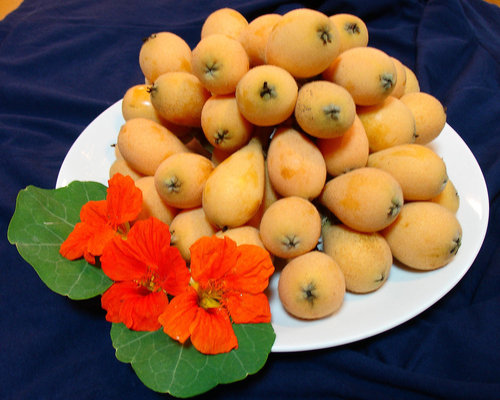Loquat fruit is the golden fruit
The loquat fruit has always been a favorite among local consumers. It looks like a miniature pipa, a four-stringed Chinese instrument that inspired the plant's Chinese name. There are records of loquat cultivation as early as the West Han Dynasty around 2000 years ago, but the fruit became popular in the Tang Dynasty (618-907).
 The loquat is indigenous to southeastern China. When it was first produced by Taiwanese farmers, it was mainly cultivated in the northern and central part of the island. It was only cultivated on a relatively small scale at first, however, because of the fruit's small size and limited amount of flesh. During the Japanese colonial period, a new bigger variety with plump golden-yellow flesh was introduced and then became popular. Now, loquats are grown in eastern and central Taiwan in Yilan, Taitung, Taichung, Miaoli and Nantou counties. Among them, Sinshou Township and Taiping City in Taichung County are the major production areas. Loquat fruit, mostly the Mogi variety, can be harvested from February to May. It is known as the golden fruit because of its yellow or orange color, is oval or round shaped with a smooth or downy skin.
The loquat is indigenous to southeastern China. When it was first produced by Taiwanese farmers, it was mainly cultivated in the northern and central part of the island. It was only cultivated on a relatively small scale at first, however, because of the fruit's small size and limited amount of flesh. During the Japanese colonial period, a new bigger variety with plump golden-yellow flesh was introduced and then became popular. Now, loquats are grown in eastern and central Taiwan in Yilan, Taitung, Taichung, Miaoli and Nantou counties. Among them, Sinshou Township and Taiping City in Taichung County are the major production areas. Loquat fruit, mostly the Mogi variety, can be harvested from February to May. It is known as the golden fruit because of its yellow or orange color, is oval or round shaped with a smooth or downy skin.
Good loquat fruits have a tender texture with a sweet and slightly acidic flavor. The tasty fruit has high nutritional value because it contains carbohydrates, dietary fiber, calcium, phosphorous and iron and is also an excellent source of vitamin B and C and carotene. Loquat fruits are also popular as an ingredient in jams and jelly, or poached in tea. Loquat leaves can be made into loquat syrup and cough drops used in Chinese medicine for soothing the throat.
Some simple tips on the fruit:
1.Picking loquats
When buying loquat fruit, choose fruit with a smooth, unbruised yellow skin with white hairs on the top and bottom. Consumers are recommended to buy loquats that are large and have thick flesh close to the stems.
2.Storing loquats
Keep them in a cool place for no more than four to five days, but they do not necessarily have to be stored in the refrigerator.
